Personal Details
Born: 22 August 1889 in Hinstock, Shropshire.
Family: He was the third of four children born to William Jackson, a general labourer, and his wife Mary. Our research suggests he never married.
Residence: In 1891 he lived with his parents, siblings, grandmother, aunts and uncles at Mill Green, Hinstock, Shropshire. In 1901 he was living with his parents and siblings at 26 Watergate Street, Whitchurch. By 1911 they had moved to 5 Deermoss Road.
Employment: In 1911 he was an ironmonger’s assistant.
Died: Not known
Military Details
Regiment: Royal Engineers (previously Somerset Light Infantry, Royal Welsh Fusiliers and King’s Shropshire Light Infantry)
Rank: Private
Service Number: 368500 (previously 44437, 52334, 22038 and 21356)
Date of Enlistment: Not known
Date of Discharge: Not known
Reason for Discharge: Not known
Other Information: Thomas’s brother Charles Greville also served in WW1.
Thomas was awarded the Campaign Medals (British War Medal, and Victory Medal).

The British War Medal (also known as 'Squeak') was a silver or bronze medal awarded to officers and men of the British and Imperial Forces who either entered a theatre of war or entered service overseas between 5th August 1914 and 11th November 1918 inclusive. This was later extended to services in Russia, Siberia and some other areas in 1919 and 1920. Approximately 6.5 million British War Medals were issued. Approximately 6.4 million of these were the silver versions of this medal. Around 110,000 of a bronze version were issued mainly to Chinese, Maltese and Indian Labour Corps. The front (obv or obverse) of the medal depicts the head of George V. The recipient's service number, rank, name and unit was impressed on the rim.
The Allied Victory Medal (also known as 'Wilfred') was issued by each of the allies. It was decided that each of the allies should each issue their own bronze victory medal with a similar design, similar equivalent wording and identical ribbon. The British medal was designed by W. McMillan. The front depicts a winged classical figure representing victory. Approximately 5.7 million victory medals were issued. Interestingly, eligibility for this medal was more restrictive and not everyone who received the British War Medal ('Squeak') also received the Victory Medal ('Wilfred'). However, in general, all recipients of 'Wilfred' also received 'Squeak' and all recipients of The 1914 Star or The 1914/1915 Star (also known as 'Pip') also received both 'Squeak' and 'Wilfred'. The recipient's service number, rank, name and unit was impressed on the rim.

